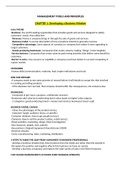Class notes
Management Tools and Principles Concepts and Vocabulary
- Course
- Institution
- Book
All basic concepts of Business Administration and Management are covered here. It includes all the key vocabulary and explanations of the chapters.
[Show more]




